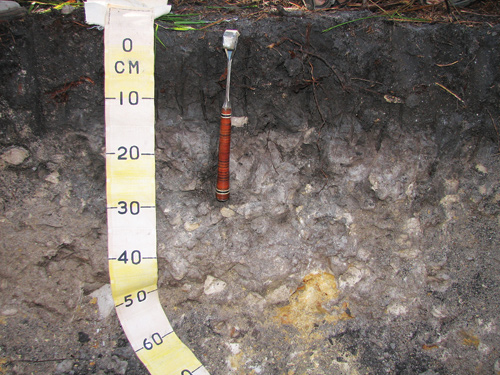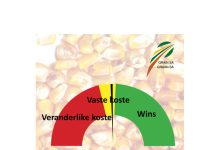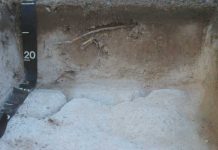Soil is the most fundamental resource for the farmer, without which food and natural fibre cannot be produced. This article forms part of a series to highlight this resource.
Organic material only makes up a small fraction of the soil and in the majority of the grain areas in South Africa, this fraction is exceptionally small. This article attempts to place in perspective the effect of organic material on the chemical and biological properties of South African soils.
Plant and animal waste which is added to the soil, is broken down by enzymatic action to form the organic building blocks. During this process, water and CO2 are released as by-products. The basic building blocks comprise a variety of organic molecules which, in turn, are bound together via enzymatic action to form stable organic molecules. Depending on the nature of the original added organic material, only about one to ten percent of the original dry mass is eventually stored in the soil as humus. The rest is mineralised to form CO2 and plant nutritional substances. From this it may be deduced that several tons of organic material must be added to the soil annually over time in order to significantly raise the humus content in the soil.
Effect of organic material on chemical properties of soil
Organic material has a significant effect on the chemical properties of soil. It makes a substantial contribution to the soil’s cation exchange capacity and plant nutrition. In order to understand this better, the most important properties that influence the soil’s chemical properties must be listed.
- The microscopic humus particles comprise mainly carbon (44%), oxygen (40%), hydrogen (8%) and ash (8% – N, S, Ca, P, Mg and K);
- Die specific surface of humus is very large (approx. 800 m2/g), which makes it highly reactive;
- The humus particles, as with clay, are negatively charged with a cation exchange capacity of 150 – 300 cmolc/kg and can therefore adsorb cations;
- The cation exchange capacity is pH dependent (the higher the pH, the higher the charge);
- The water holding capacity is three to four times that of clay;
- The exchange reactions are very similar to those of clay and therefore provide exchangeable cations in the same way as clay.
Cation exchange capacity
Relative to the other sources of cation exchange capacity, humus has a much higher cation exchange capacity. This means that humus has the potential to render a significant contribution to the soil’s cation exchange capacity, even though it makes up a relatively small part of the soil mass. In Table 1 one may see the relative contributions of clay and humus to cation exchange capacity in a typical sandy soil with 10% clay (9% kaolinite and 1% smectite) from the western grain producing areas. At a typical 2% humus content the contribution it makes to the cation exchange capacity thereof is 31%. In sandy soil with a clay percentage of less than five percent, 0,2% humus can contribute more than 50% to the soil’s cation exchange capacity.

Provision of plant nutrition materials
Plant material that is added to the soil, contains the full range of plant nutrients. It is broken down by microbes to the basic minerals (mineralisation) and during this process, apart from large quantities of CO2, plant nutrients such as nitrogen, sulphur and phosphor is also released. Proteins are broken down by microbes into amino acids and further to ammonia and sulphides and later to nitrates and sulphates. Besides this, cations such as Ca2+, Mg2+ and K+ are released which, in turn, are adsorbed in the exchange complex.
Humus usually contains about 5,3% nitrogen on a mass basis. In the sandy soils of the western grain producing areas (with 0,2% humus), there can be about 370 kg of nitrogen per hectare in the top 250 mm of soil. This is a rather large amount and in soils with higher organic material levels, this figure is much higher. For the agriculturalist, however, it is not available for plant nutrition, unless the organic material levels are allowed to mineralise.
The ratio of C:N:P in soil organic material is in the region of 110:9:1 on a mass basis. This provides an indication of the amount of P that is present in the organic fraction of the soil. Together with this, virtually all the sulphur in the soil is also present in the organic fraction, with only a small quantity being mineralised to the inorganic fraction (sulphides and sulphates). In the areas where acid rain occurs, the inorganic fraction of sulphur is higher. A typical ratio of N:S is 10:1. There is also a quantity of potassium locked up in organic material. When the organic material mineralises, the potassium is released as K+, which is then adsorbed on the exchange complex. From here it is exchanged and taken up by plants.
Ca2+ and Mg2+ are made available to plants on the exchange complex. In sandy soil, where the cation exchange capacity(clay) is very low, the humus plays a major role in contributing to the soil’s cation exchange capacity and is therefore also of major importance in calcium and magnesium nutrition. Furthermore, it is also a source of these two elements as plant nutrition when organic material mineralises.
Organic material in soil also contains the full range of micro-elements in the form of humus-metal complexes and chelates. Apart from copper, all the micro-elements are kept in the soil and made available for plant nutrition by the humus exchange reactions and chelate properties. Without humus, the provision of micro-elements for plants is almost impossible and it is one of the most important functions in soil in terms of plant nutrition.
Table 1: The relative contribution of clay and humus to the cation exchange capacity in a typical sandy soil of the western copping area
| Percentage (mass basis) | Soil particles | Cation exchange capacity (clay/OM) (cmolc/kg) | Cation exchange capacity (soil) (cmolc/kg) | Percentage contribution |
|---|---|---|---|---|
| 80 | Sand | 0 | 0 | 0 |
| 9,8 | Silt | 0 | 0 | 0 |
| 9 | Kaolinite (clay) | 5 | 0,45 | 23 |
| 1 | Smectite (clay) | 90 | 0,9 | 46 |
| 0,2 | Humus | 300 | 0,6 | 31 |
| 100 | 1,95 | 100 |
The carbon to nitrogen ratio
The ratio of carbon to nitrogen of humus in the soil is reasonably constant and ranges between 10:1 and 12:1. When plant material is incorporated into the soil, the number of microbes that are responsible for the breaking down of material, increases drastically. Should the plant material be wheaten straw or maize residue, the majority of the plant parts have a C:N ratio greater than 50:1 (up to 80:1), with the result that there is much more carbon in the soil and little nitrogen. In order to assimilate the organic material, the microbes absorb all the available nitrogen in the soil (including fertiliser), with the result that there is now too little nitrogen for crops to grow (the so-called nitrogen-negative period). During the breaking down of the material, the majority of the carbon in the material is released as CO2 and the nitrogen remains intact until the 12:1 ratio is once again attained and the nitrogen is then released again when the multitude of microbes, who have stored the nitrogen in their bodies as protein, die. During this process, some of the nitrogen and carbon builds up in the soil as humus. In order to counteract the nitrogen-negative period, additional nitrogen may be worked into the soil along with the residue material. The residue is then broken down more rapidly.
Buffer capacity
As humus influences the cation exchange capacity of the soil, it also influences the amount of H+ and Al3+ which can bind onto the complex, and thus the amount of exchangeable acid. This means that soil with a high humus content can bind more acid onto the exchange complex which, when lime is added to the soil, flows back to the acidity in the soil solution therefore causing the soil pH to react poorly with the lime initially. The opposite is also true – soil with a high humus content takes longer to become acid, as a large amount of the active acid is adsorbed from the solution on the exchange complex. Liming should be done before acid on the exchange complex adsorbs, which means that one should strive towards a base saturation of 100%.
The effect of organic material on biological soil properties
Addition of organic material to soil is the nutritional source (energy source) of virtually all forms of life in the soil. Soil life is responsible for the breaking down and recycling of all waste products from man, animals and plants. Diversity in soil life is also important for sustainable plant production. In order to maintain this diversity, the source of the nutrition must also be diverse, so that all can live life in balance. When a single crop is planted over the years in a monoculture, certain species are advantaged and others disadvantaged, causing an imbalance in biodiversity. This leads to species becoming pathogenic due to their large numbers. Some microbes release an antibiotic which keeps the numbers of others under control and if these microbes do not get food, they become too few and the others flourish. The basic principle for the agriculturalist is therefore to rotate the crops so that the population diversity in the soils may be “healthy”.
Management of organic material in soil
A few basic principles that should be borne in mind during the management of organic material in soil, are:
- It does not make sense to strive towards higher humus levels in the soil than that which the soil/plant/climate system can sustain. Greater additions lead to increased microbe activity and leads to more rapid breaking down, which will continue until the soil/plant/climate system causes equilibrium.
- Due to the reasonably fixed C:N ratio, adequate nitrogen must be added to the system to build up the humus level to the optimal equilibrium level. The planting of leguminous crops in a crop rotational system that binds atmospheric nitrogen, makes a significant contribution here.
- Organic material must continuously be added to the system in order to maintain the equilibrium.
- Growth conditions of the crops must be optimised so as to produce adequate quantities of organic material.
- Mixing of soil via mechanical action should be kept to a minimum and organic material should preferably be left on top of the soil. Only one ploughing event of the soil every four years is enough to destroy all the accumulated organic material.
Summary
The management of organic material in soil is one of the most important challenges in modern agriculture. It is a sustainable way in which to immobilise, in the soil, the carbon dioxide in the atmosphere which, inter alia, is responsible for the greenhouse effect. Furthermore, it has a number of advantages for the agriculturalist. It improves the soil’s physical, chemical and biological properties to such an extent that it benefits the production of food and fibre in the long-term. Producers should introduce farming practices that slow down the degradation of organic material in the soil and encourage the supplementation thereof.
For further information, please contact the authors on:
Martiens du Plessis: martiens@nwk.co.za
Prof Cornie van Huyssteen: vanhuyssteencw@ufs.ac.za
REFERENCES
Brady, NC. 1990. The nature and properties of soils. 10th ed. Macmillan publishing company, New York.
Allison, FE. 1973. Soil organic material and its role in crop production. Elsevier Scientific Publishing Company, New York.


















